A star path finding method and system based on binary heap node sorting
A binary heap and heap sorting technology, which is applied in the A-star pathfinding method and system field based on binary heap node sorting, can solve problems such as slowdown, slow efficiency, and inability to meet the real-time requirements of the game, so as to improve execution efficiency Effect
- Summary
- Abstract
- Description
- Claims
- Application Information
AI Technical Summary
Problems solved by technology
Method used
Image
Examples
Embodiment 1
[0049] figure 1 The flow chart of the A-star pathfinding method based on binary heap node sorting provided by the embodiment of the present invention is shown in the figure: the A-star pathfinding method based on binary heap node sorting provided by the present invention includes the following steps:
[0050] S1: Initialize the OPEN table, the CLOSE table and the target point A, put the starting node S into the OPEN table, and empty the CLOSE table;
[0051] S2: Determine whether the OPEN list is empty, if not, take a node n from the header of the OPEN list; if yes, end the algorithm process;
[0052] S3: Determine whether node n is the target solution A, if yes, then output node n; if not, go to step S4; the target solution is the target point A to be found at last, that is, find a path from the starting point to reach Target;
[0053] S4: Expand all the successor nodes of node n to form directly associated sub-nodes, determine whether the sub-nodes are in the CLOSE table,...
Embodiment 2
[0086] The difference between this embodiment and embodiment 1 is only:
[0087] This embodiment describes in detail the A-star pathfinding method based on binary heap node sorting. The method provided in this embodiment is to introduce a binary heap into the A-star algorithm to sort nodes, thereby improving the efficiency of the algorithm. The specific process is as follows:
[0088] 1. Initialize an OPEN table (for storing the next node to be traversed), a CLOSE table (for storing the path that has been found), put the starting node S into the OPEN table, and empty the CLOSE table;
[0089] 2. If the OPEN table is not empty, take a node n from the head of the table, if it is empty, the algorithm fails;
[0090] 3. Determine that node n is the target solution, if so, find a solution (continue to search, or terminate the algorithm); if not, go to step 4;
[0091] 4. Step 4 is divided into the following steps
[0092] 4.1. Expand all the successor nodes of node n, that is, th...
PUM
 Login to View More
Login to View More Abstract
Description
Claims
Application Information
 Login to View More
Login to View More - R&D
- Intellectual Property
- Life Sciences
- Materials
- Tech Scout
- Unparalleled Data Quality
- Higher Quality Content
- 60% Fewer Hallucinations
Browse by: Latest US Patents, China's latest patents, Technical Efficacy Thesaurus, Application Domain, Technology Topic, Popular Technical Reports.
© 2025 PatSnap. All rights reserved.Legal|Privacy policy|Modern Slavery Act Transparency Statement|Sitemap|About US| Contact US: help@patsnap.com


